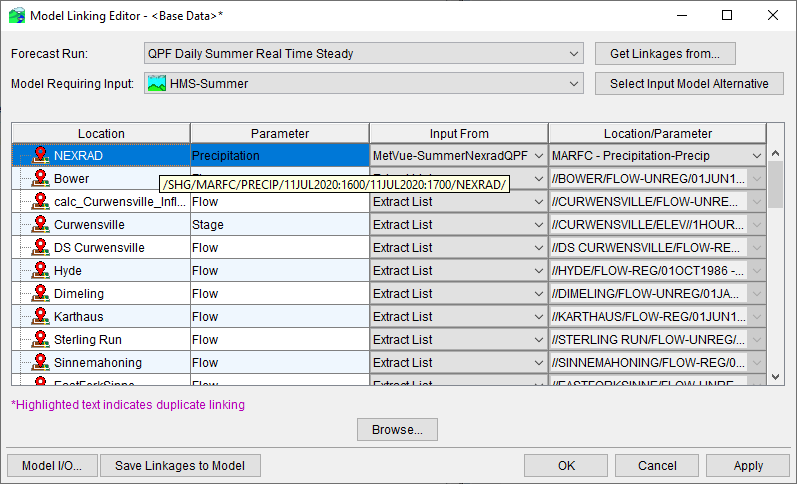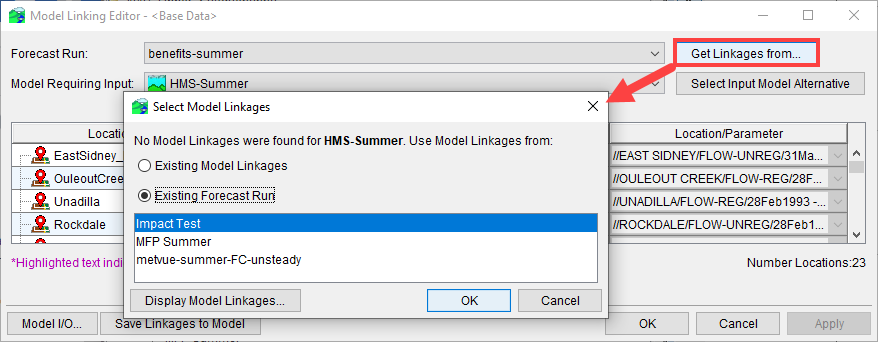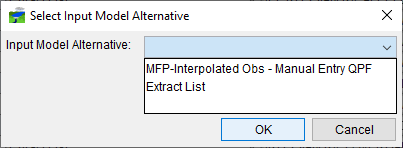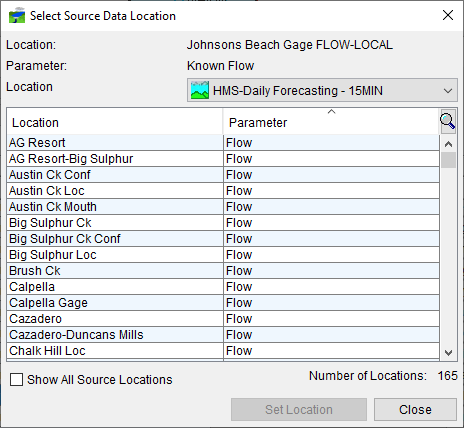Download PDF
Download page Model Linking Editor Overview.
Model Linking Editor Overview
The title bar of the Model Linking Editor indicates whether the linking pertains to the Base watershed or a specific forecast.
At the top of the Model Linking Editor, select the forecast run that you wish to link from the Forecast Run drop-down list. The Model Requiring Input list displays the model alternatives configured for use in the selected forecast run. To complete the model linking process for a given forecast run, you will need to step through all the model alternatives listed in the Model Requiring Input list. The remaining portion of the Model Linking Editor is the table which lists the inputs required by the model alternative selected in the Model Requiring Input list and the source of that input. The figure below shows an example of the Model Linking Editor for a watershed with an HEC-HMS model alternative requiring input.

This table has four columns:
- Location - This column identifies the name of the required input. For example, this could be:
- The precipitation grid name or discharge gage name specified in the HEC-HMS model alternative.
- The local flow name specified in the HEC-ResSim model alternative.
- The river station and node name specified in the HEC-RAS model alternative.
- Parameter - This column identifies the type of data or information required by the model alternative. For example, this could be: flow, stage, or precipitation.
- Input From - This column consists of lists that identify the source of the input. These lists display each available model alternative from the selected forecast runs and the Extract List. The Extract List is used to bring data and information from external sources (i.e., CWMS database, HEC-DSS file, Cumulus, CDA, etc.), into the watershed. Refer to Data Extract and Post Editors for additional information on the Extract Editor.
- Location/Parameter - If the Input From column displays the name of a model alternative, this column provides a list that contains all of the model alternative results for the parameter specified in Parameter column. For example, in the figure above, the first row in the table indicates that the NEXRAD precipitation input should come from the HEC-MetVue model alternative named MetVue-SummerNexradQPF. If the Input From column displays Extract List, this column will display an HEC-DSS pathname located within the forecast.dss file.
Get Linkages From
The Get Linkages from... button allows you to set model linking from Existing Model Linkages or Existing Forecast Runs. For example, the Impact Test forecast run might have updated model linking that you tested. If you want to use the linkages from that forecast run, you could select the forecast run as the model linking to be used in your base model.

Select Input Model Alternative
The Select Input Model Alternative button provides you with a way set all of the Input From values to a specific model alternative or to the Extract List. For example, you may want all the HEC-ResSim model alternative inputs to come from the HEC-HMS model alternative results. Click Select Input Model Alternative, the Select Input Model Alternative dialog opens. In the dropdown, select a model alternative (or Extract List), click OK, the Select Input Model Alternative dialog closes.
A Confirm Input Selection window will open, asking you if you want to link all unlinked rows to the selected Input Model Alternative. Click Yes, and the Confirm Input Selection window will close. All rows in the table that were not linked will now be linked to the selected Input Model Alternative.

Select Source Data Location
Towards the bottom of the Model Linking Editor is the Browse button that opens the Select Source Data Location dialog. In this dialog you can scroll through the entire list of available locations and parameters for the model alternative specified in the drop-down list at the top of the dialog. To set a Location/Parameter, highlight a row in the Model Linking Editor, and then highlight the desired row in the Select Source Data Location dialog. Click the Set Location button at the bottom of the dialog.

On the bottom left of the user interface are two more options: Model I/O and Save Linkages to Model. The Model I/O option shows the model input and output per each forecast or base model. The model input is very similar to what is seen in the Model Linking Editor. The Output options show how the output data is saved. In the example below the path ends in "Q0", indicating this data is associated with this HEC-MetVue alternative.

The Save Linkages to Model option will save the model linking to the linkages file (found in the cavi/modelLinking folder of the watershed). This is the location where base model linking is saved on disk.